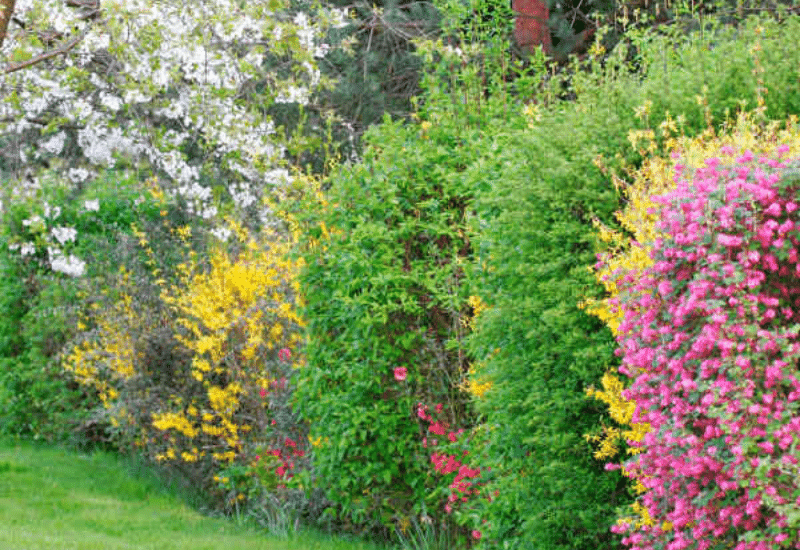
If you don’t feel like the same green manicured box or privet over and over again, you don’t have to do without privacy protection entirely: hedges with flowers are much more attractive as privacy screens than bare fences and walls.
Flowering hedge makes it possible to delimit a property and to bring a little intimacy while being lively, cheerful and colorful throughout the year.
The evergreen uniformity of the conifers is countered by flowering shrubs that change all year round.
From delicate leaf sprouting and gorgeous and fragrant blooms in spring or summer to a lush dress of leaves in the middle of the year to bright leaf colors and attractive berry decorations in autumn.
Hedges with blossoms are not just pleasing to the eye, they are also an enrichment for the biodiversity in the garden. The flowers often attract numerous pollinators while birds like to use the hedges as a retreat.
A variety of robust, flowering shrubs are suitable for blooming hedges. All you need to do is choose a blossoming shrub like forsythia for a spring burst or repeat blooming Japanese roses for long lasting blossoms!
Here is our selection of flowering shrubs that you can use to create eye-catching privacy hedges. We have chosen hardy, easy and fast-growing varieties so that you can enjoy an effective and decorative year-round privacy screen as quickly as possible.
How To Grow Great Flowering Hedges
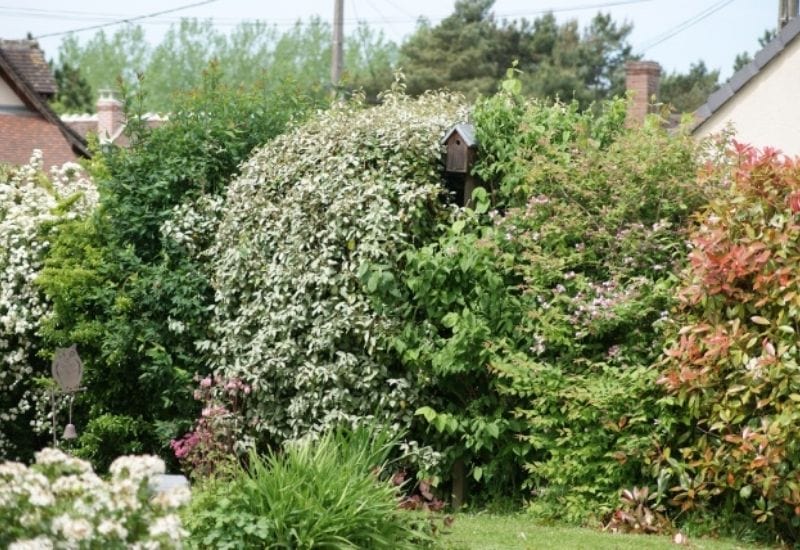
Hedges have specific roles in gardening, and a good flowering hedge needs some attention in design and concept. So, we are going to see some quick but clear guidelines about this art.
Decide What You Want from Your Hedge
The first step is to decide why you want a hedge. Do you want to define your property? Or do you want to block off peering eyes?
Or maybe you just want to create different zones within your green space? So, choose:
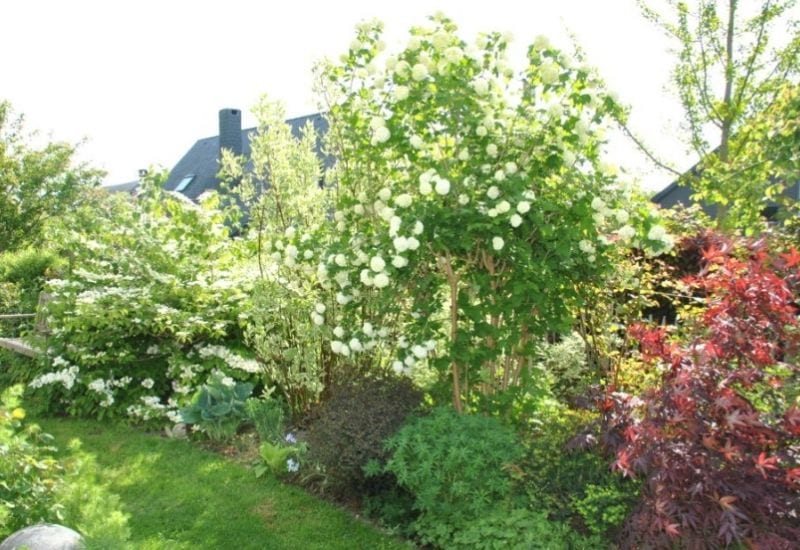
So, now you have made up your mind about why you want a hedge, let’s see what type of hedge you like.
Decide What Kind of Hedge You Want
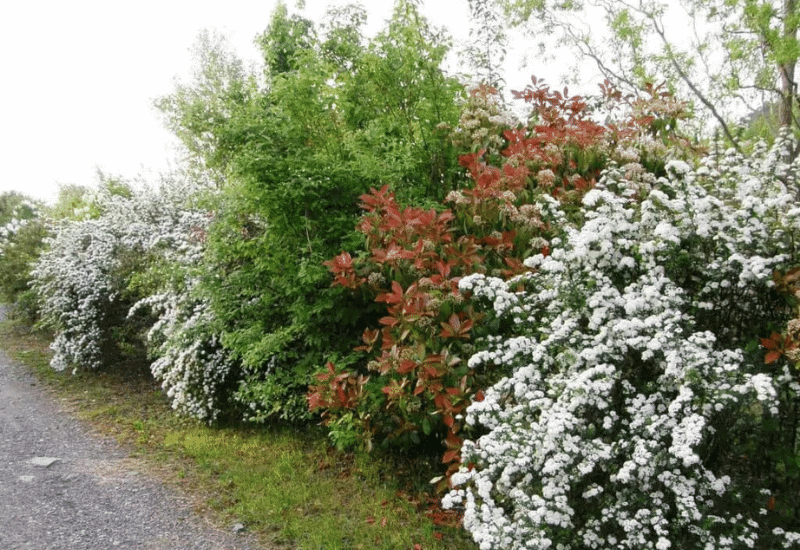
Hedges are all different, they range from topiaried mazes to broad and naturalized winding bushes. They range along a line of formality and informality. Let’s talk about them…
Finally, there are a few elements you want to consider.
Decide the Qualities You Want from Your Hedges
There are then aesthetic and practical factors you will also need to consider before you choose the best flowering shrub for your hedge. Here they are.
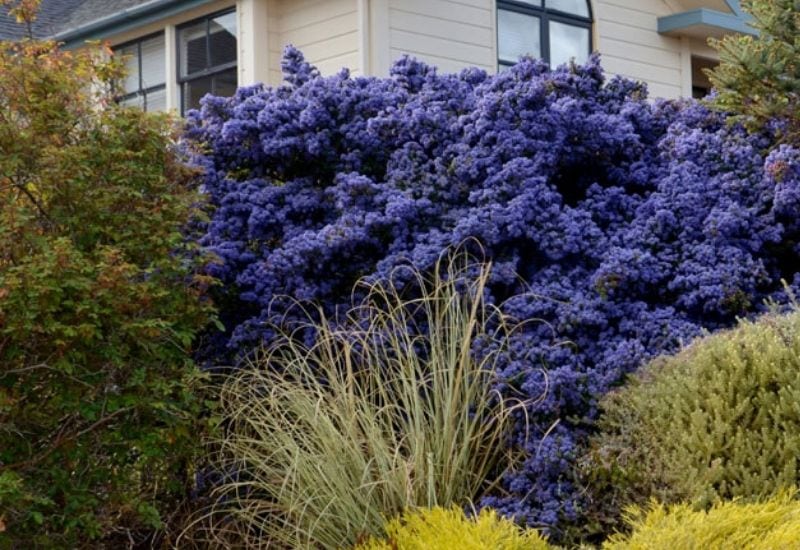
Ok, now get ready to choose your flowering shrubs and be amazed, because we are going to see them next!
Read carefully the details and tips of the beautiful flowering hedges you are going to meet, because you need to match them with your need and design. Ready, steady, go!
12 Flowering Shrubs For Privacy Screens And Hedges
Flowering hedges, which reach a growth height of 2-3m, not only inspire with their eye-catching splendor, but also protect against wind and dust and the prying eyes of the neighbors.
Here are 12 stunning flowering hedge plants for creating year-round privacy screen.
1: Japanese Quince (Chaeonomeles speciosa and Chaenomeles japonica)
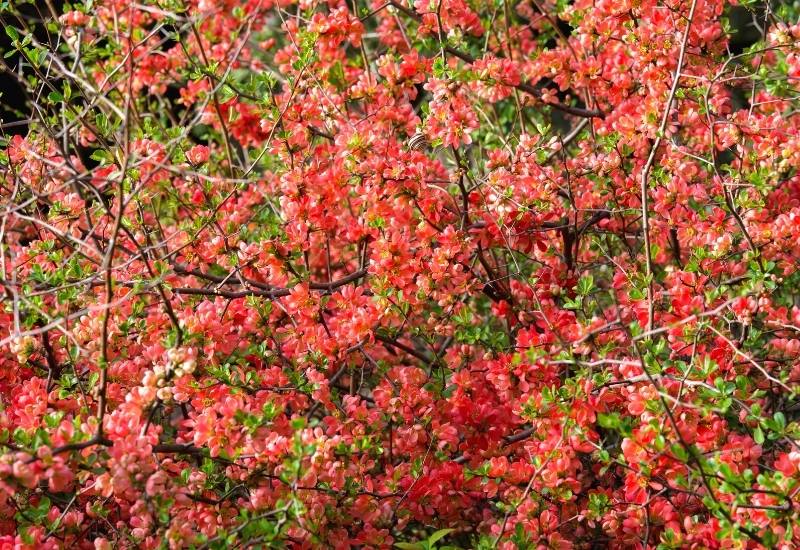
Japanese quince is a deciduous shrub with very soft looking blooms for your hedge in spring.
The flowers can be single, like in the pastel rose ‘Tokyo Nishiki’ or double like in the lime green ‘Kinshiden’ or the flaming orange red ‘Double Take Orange’, but they always have a very rounded shape, and they are about 1.5 inches across (4.0 cm).
They will come on the branches in the early season when the leaves green. Then, the foliage will darken and thicken, and fragrant fruits will grow among it.
It is not very dense nor thick, but the color range of the flowers is amazing. And birds love it!
I would suggest Japanese quince for a very natural, even forest looking hedge, especially due to the irregular branches.
It can be mixed in with other shrubs for hedges when you don’t need an impenetrable hedge.
2: Koreanspice Viburnum (Viburnum carlesii)
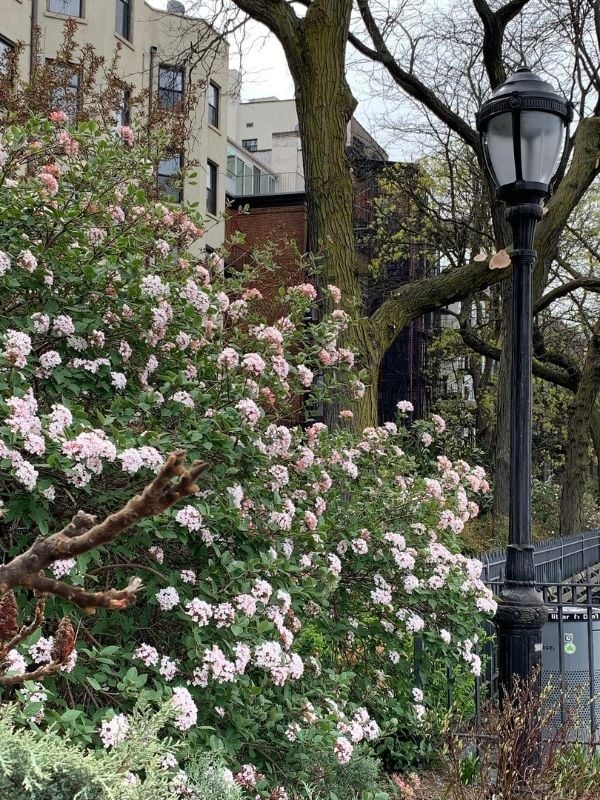
Koreanspice viburnum is a perfect flowering shrub for informal hedges that need a blush of color and fragrance from spring to fall.
The large clusters of white or pink white flowers will come repeatedly with their five petaled blooms among the mid green foliage for months, and their spicy but sweet fragrance will fill your garden.
The leaves are broad and almost cordate and veined, quite dense and copper in spring, dark green in summer and red in fall. The berries that ripen on the branches will turn bright red and attract winged visitors.
Koreanspice viburnum is a good shrub for informal and temperate looking gardens; it adapts to urban and rural settings as well as to naturalized areas.
It is cold hardy and it would be a good way of ring fencing your garden from people, while giving animals a lovely sheltered corridor.
3: Forsythia (Forsythia spp.)
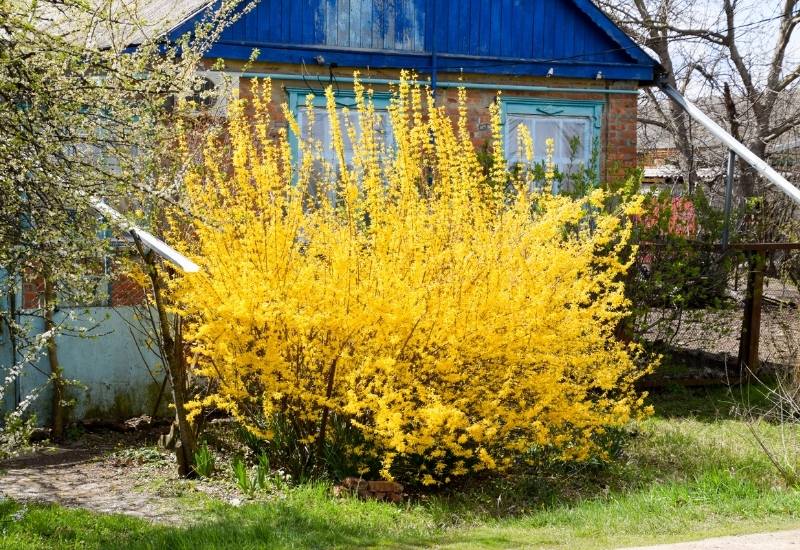
Forsythia will put on a display like no other shrub in your hedge in spring! The sea of bright golden yellow flowers will literally light up your garden for a few weeks.
They are small, true, but they are so many that they will literally cover all the plants! They come straight on the branches before the leaves and announce the good season in style!
Blooming at the same time as daffodils, it is a great and reliable start of the year. Then the leaves will give you a dense bush with many branches that you can prune easily and keep thick to block views. It also provides a good corridor for small mammals and a shelter for birds.
Plant border forsythia (Forsythia d intermedia) for straight and even upright branches to form a tall hedge,
but if you need a draping shrub to soften small walls, you also have the option of weeping forsythia (Forsythia suspensa) or the beautifully arching Korean forsythia (Forsythia ovata).
4: Mock Orange (Philadelphus spp.)
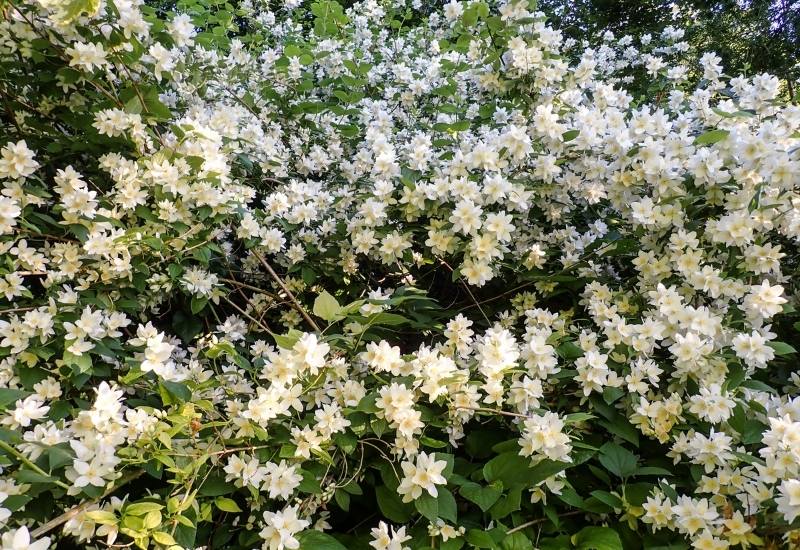
As a shrub, mock orange gives you a green hedge from spring to fall and showy white blooms in late spring and early summer.
The four petaled blooms can reach 2 inches across (5.0 cm) and they have beautiful yellow anthers and sometimes even a dash of lavender at the center.
What is more, they are very fragrant, with a citrus aroma, and they come abundantly on the tips of the branches.
The bright and mid green foliage is elliptical and herbaceous in appearance, growing opposite on the arching branches.
The ‘Belle Etoile’ cultivar has won the Award of Garden Merit by the Royal Horticultural Society.
Mock orange is perfect for informal hedges in suburban gardens, but if you live in a rural area, it is also great.
Perfect to shape rooms in English country and traditional gardens, it brings you a fresh and light atmosphere like few other shrubs do.
5: Nevin’s Barberry (Berberis nevinii)
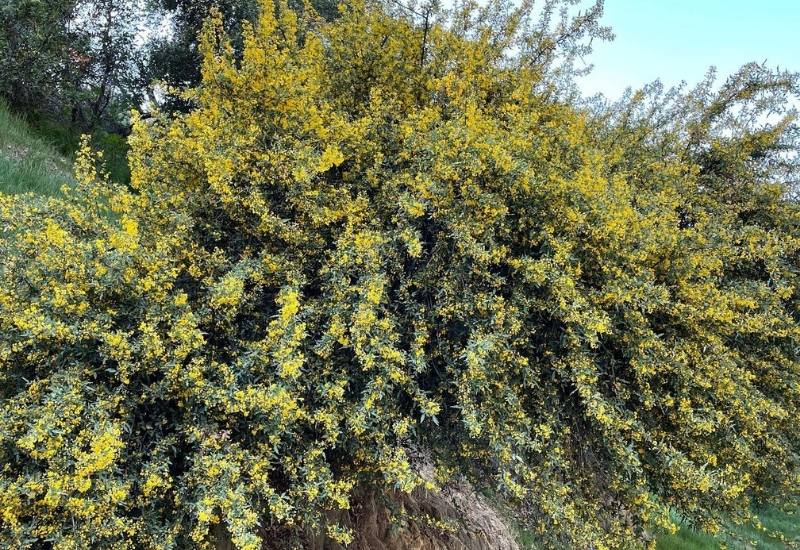
Nervin’s barberry gives you evergreen foliage all year round, blooms in spring and bright red berries in summer – perfect for a garden hedge!
The blooms are yellow and like small daffodils drooping in clusters from the branches. The fruits will follow with their translucence starting off greenish, to then turn yellow and finally crimson.
Birds will fill your garden in this season, because they love them! The leaves are long and spiked, similar in a way to those of holly, dark green and fairly glossy. They will form a dense bush in winter too.
Nervin’s barberry is ideal for tall hedges if you want to choose which animals you want to invite to your garden:
they welcome birds and even hedgehogs, but they form a good defense against deer – and people!
6: Japanese Rose (Rosa rugosa)
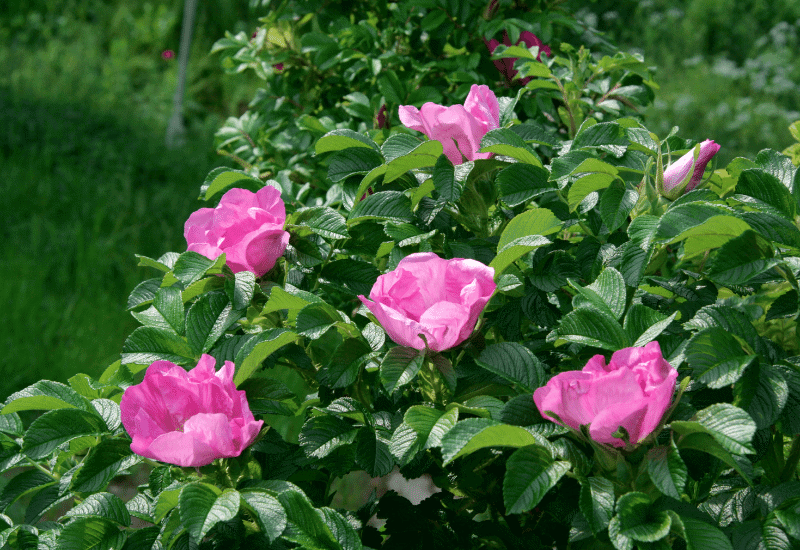
Japanese rose is a wild looking and hardy species with great qualities as a flowering shrub.
It is the mother species of many cultivar shrub roses, a massive repeat bloomer and with a very remarkable and strong fragrance.
The color ranges from white to magenta, with single, semi double and fully double varieties. The foliage is bright green and healthy, with many regular veins on the leaves.
The fruits (hips) are large and juicy, edible and they look like cherry tomatoes. It is one of the sturdiest and easiest roses to grow, and one of the most rewarding.
Japanese rose is perfect if you want a natural looking hedge that fills with wildlife all year round;
butterflies and bees will visit it for its nectar while birds will take a bite at the hips. It won’t need all the attention other roses need, which means that maintenance is manageable. Finally, it is also very cold hardy!
7: Rosemary (Rosmarinus officials)
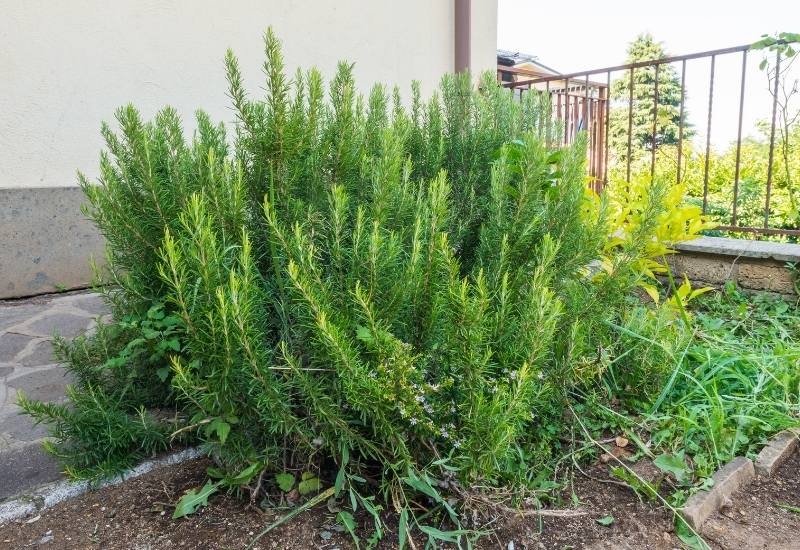
Rosemary as a flowering shrub for hedges? Why not! It grows fast and strong, it will give you massive blooms in from winter to mid spring and sometimes even in summer and fall! The lavender blue flowers are abundant and eye catching.
The foliage is very fragrant, thick and evergreen, so you can have a lively hedge all year round. What else?
It can be pruned and thickened easily; it is almost disease free and yes… you can use it to cook!
I forgot, it also keeps deer at bay and it it will tolerate drought and coastal regions with salty air and soil. Have I convinced you?
Rosemary is an all purpose shrub for hedges in informal gardens of most types; it is ideal for a Mediterranean garden, but it is also excellent for other designs, from xeric to urban gardens, gravel gardens and simply traditional ones.
8: Mountain Laurel (Kalmia latifolia)
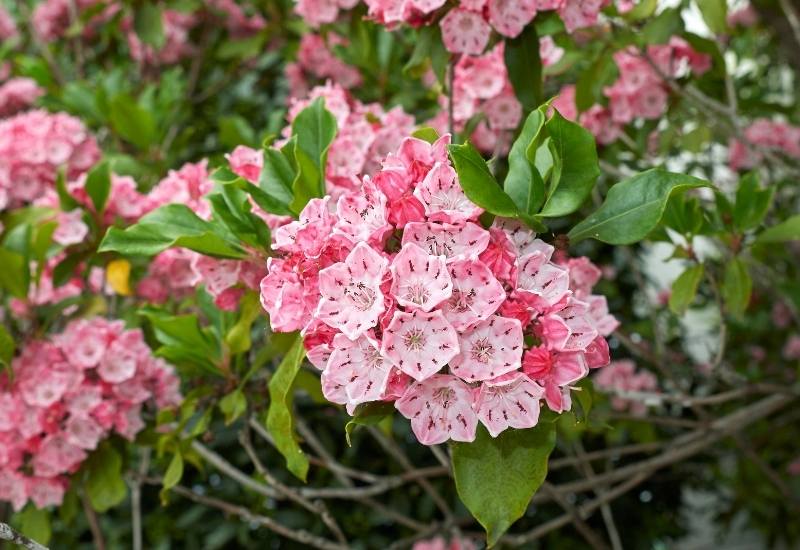
With mountain laurel you will have a green hedge all year round and beautiful blooms for a few months as well.
The flowers are very interesting in shape, bell shaped and at the same time they have a pentagonal opening.
They are light pink with regular darker pink dots inside, one for each side of the “pentagon”.
The anthers are purple pink too to complete the effect. The foliage is not very dense, and you can still see the branches, but it’s beautiful.
Glossy and leathery, oval in shape, it changes color through the year: it is light green in spring, dark green throughout the summer months and finally purple later in the season.
Mountain laurel is best as a hedge within your garden, to create rooms and delimit spaces;
the foliage leaves gaps where you can see through. But for natural looking private corners is can be a very interesting plant all year round thanks to its always changing look.
9: California Lilac (Ceanothus spp.)
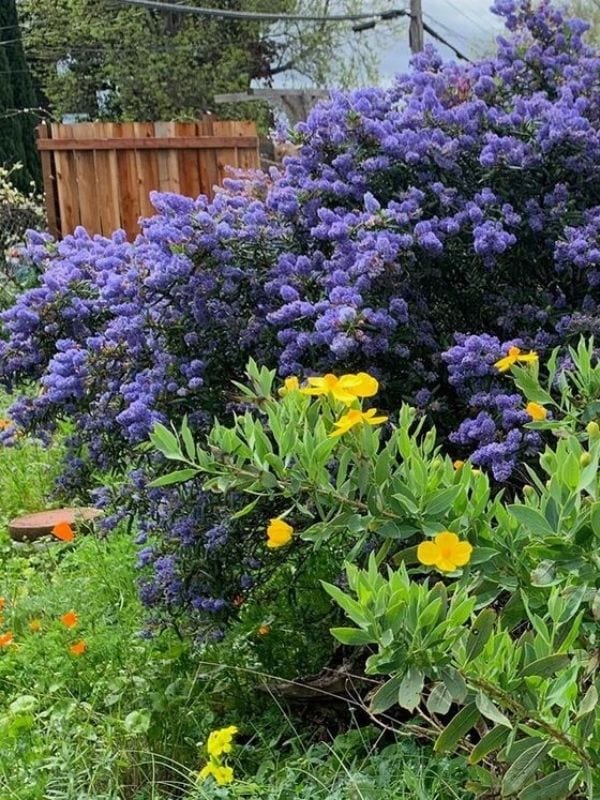
California lilac is an evergreen shrub with a spreading habit that suits very well flowering shrubs.
The large inflorescences come packed with blue to violet flowers in late spring accompanied by a very pleasant aroma.
The are conical in shape and so abundant that they cover the whole bush for weeks! The leaves are bright green, glossy and oval;
the foliage follows the branches, giving you beautiful arching and fairly regular patterns of purple brown and emerald all year round.
The ‘Dark Star’ variety is a receiver of the prestigious Award of Garden Merit by the Royal Horticultural Society.
When in bloom, California lilac will give you an impressive blue natural wall that suits all sorts of informal gardens, and it will grow well in coastal regions and dry places as well
For the rest of the year, it will give you a thick mesh of branches that can easily replace a fence.
10: Indian Hawthorn (Rhaphiloides indica)
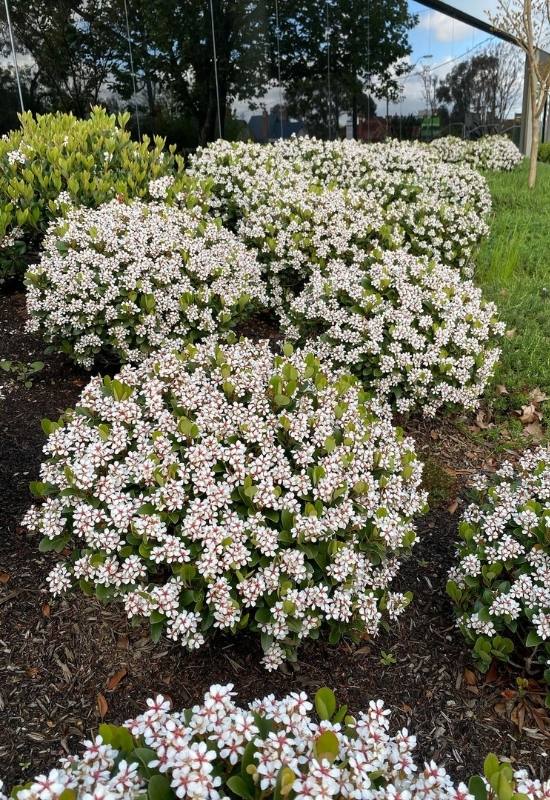
Indian hawthorn is a lesser known flowering shrubs you can use for year round hedges. It is evergreen and with a dense and round habit, dark glossy elliptical leaves that reach 3 inches in length (7.5 cm).
The flowers come on large panicles of delicate looking small flowers packed together; these will change in color as they age, from almost white to magenta through shades of pink.
What is more, they are very abundant and fragrant too! The berries that follow will stay on till winter and ripen to dark blue in color. Loved by birds, you will have a lot of company with their chirping in your garden.
Suitable to warmer climates, Indian hawthorn nevertheless has a very temperate appearance;
it looks great in bushy informal hedges in naturalistic designs and even in naturalized areas. It is thick enough to keep people off and suitable for coastal regions.
11: Oleander (Nerium oleander)
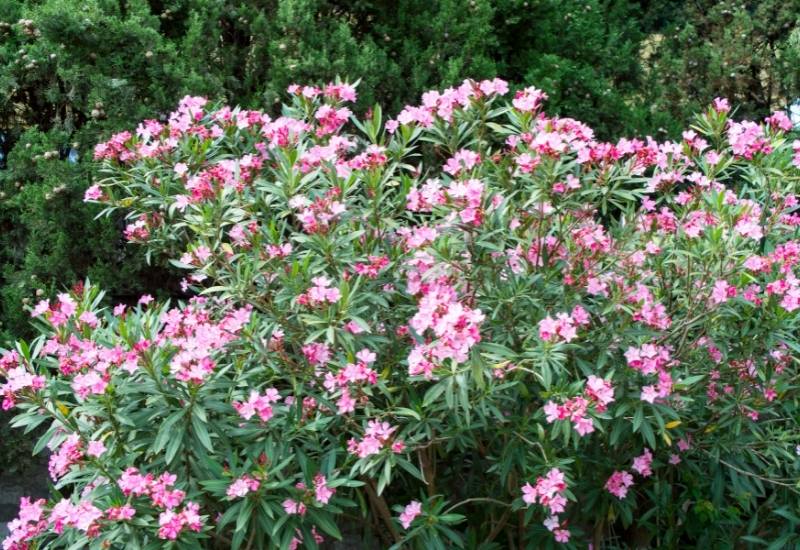
Oleander is one of the most generous flowering shrubs for hedges in the whole world! The blooms are fabulous and very fragrant, though some varieties have a stronger vanilla scent than others.
You can choose from single and double blooms from white to red via all the shades of pink and light purple in between, and don’t forget peach and yellow!
They will bloom in summer in most places, but in the perfect environment, you can get even extended blossoms all year round.
The foliage is glossy, long and oval and it will stay on all year round, giving you a thick hedge for all seasons.
Oleanders are perfect for Mediterranean and coastal gardens, but other designs will be suitable as well:
if you have an urban or gravel garden they should be top of your list, but don’t write them off with any informal setting.
12: Prickly Pear (Opuntia indica)
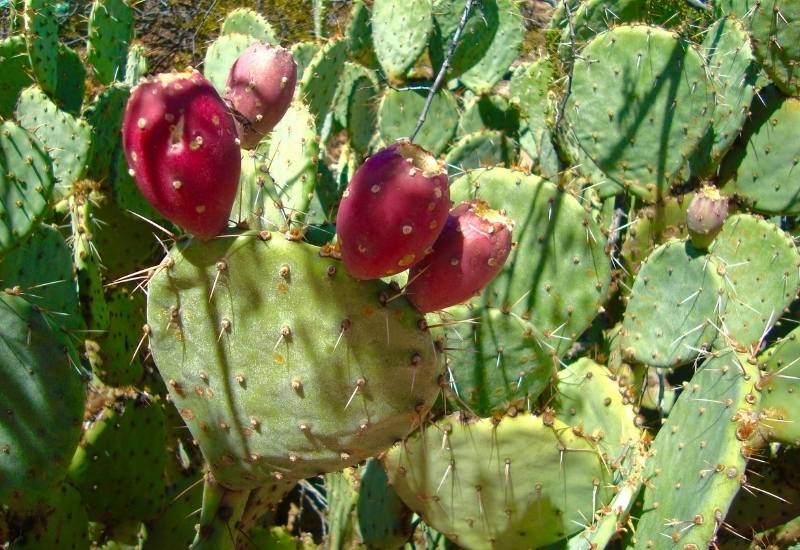
For a very exotic and unusual flowering shrub, just plant some prickly pears. These succulents form large shrubs in no time with their large mesh of pads and spikes, impenetrable and very sculptural.
The flowers have many petals and they can range from yellow to orange red, very waxy, bright and showy.
They will come straight on the pads in spring and they are followed by the famous juicy fruits of this exceptional cactus.
Do remember that the thorns are invisible on the fruits, but you can eat them too, and the flowers are good as stone breakers as well.
Easy to grow, you just need to place a pad on the ground to get a tall shrub in a few years, and you can cut it quite safely with a machete without risking to damage it.
A prickly pear hedge is perfect to delimit gardens and keep people away, rather like a stingy wall.
It will stop larger animals but it will provide a corridor for smaller ones. It will also keep off fires, protecting your garden in hot and dry regions like California.
Of course, it looks best in a desert, xeric, exotic, coastal or Mediterranean garden.
Hedges In Bloom For All Your Needs
From exotic to temperate, from evergreen to deciduous, you have seen a wide range of flowering shrubs you can use in your garden to have the perfect hedge:
one that does its job in keeping people out or limiting areas within your yard, but also one that blooms and gives you a flowery wall at least once a year, if not more!

Written By
Adriano Bulla
After many years as an academic in London, Adriano Bulla became a writer, publishing books like A History of Gardening, Organic Gardening and Elements of Garden Design; he then decided to become a gardener, following his childhood dream, and has been following his dream writing and gardening professionally in Southern Europe, where he has specialized in new and innovative organic gardening fields and techniques, like permaculture, regenerative agriculture, food forests and hydroponics.

The first photo or a vibrant dark royal blue hedge near the top of your article also a CA lilac?
Yes it is.